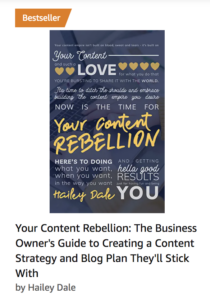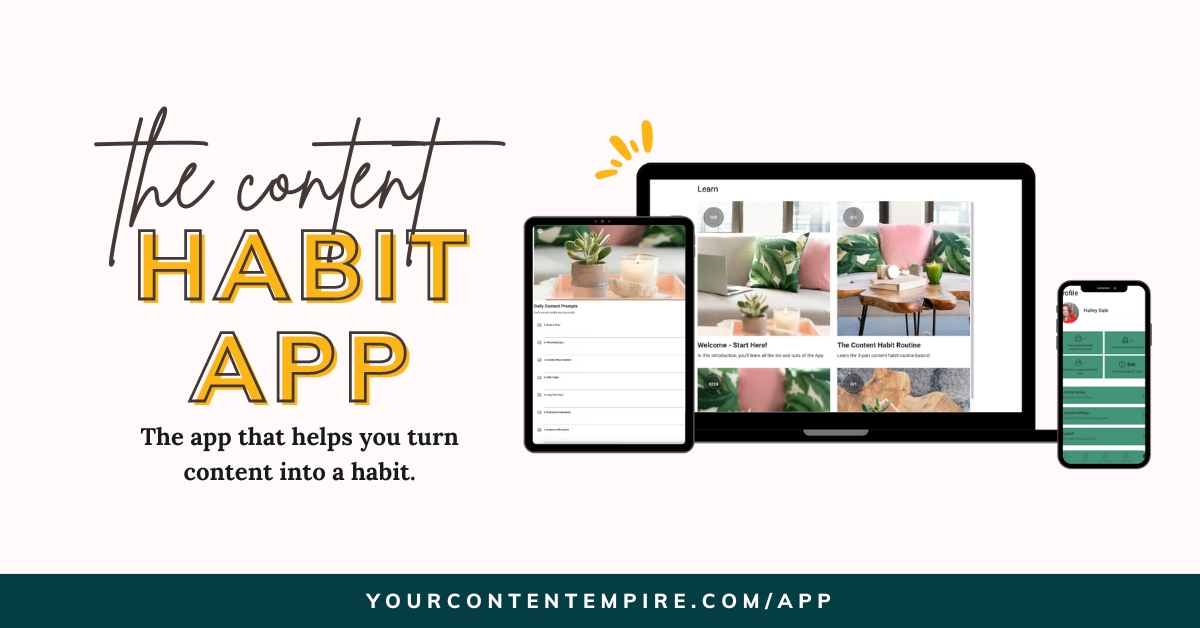Do you get excited about creating big pieces of content for your business (think courses, books, webinars, launches, digital products, sales funnels, etc.)…only to have those dreams dashed by overwhelm?
With everything you’re already fitting onto an overflowing plate as a business owner, finding the time to make these bigger, longer-term projects a priority is a T-O-U-G-H-I-E.
Prefer to watch instead?
I was an English major in my undergrad and like most people who find themselves studying literature, did so because I love to read books. And so I always dreamt of writing my own. It was on my business bucket list for years, and it was something I kept pushing off and off to each new year because it’s really time-consuming to write a book.
 It wasn’t until I decided to rework my approach for writing a book that Your Content Rebellion finally became a reality and in one of my proudest biz high-fives to myself, an Amazon best seller.
It wasn’t until I decided to rework my approach for writing a book that Your Content Rebellion finally became a reality and in one of my proudest biz high-fives to myself, an Amazon best seller.
But that’s getting a little ahead of myself. When it came to actually writing the book, it’s something I put off for YEARS (you can read about the full journey here). I’d put it on my goal list year after year, and while I would complete almost every other goal on my list, this was the one I kept having to move forward.
So how did I finally get it done?
The year I finally did, I knew the first thing I needed to do was cultivate a consistent writing habit (if you want to know more about this, I wrote a whole post about how to build a consistent content creation habit in 90 days to walk you through it).
The second thing I decided to do was break down the writing into smaller, more manageable pieces. By putting my content habit on laser focus with a clear plan, I was able to bring this goal to fruition—something I’m really proud of.
So why am I telling you this? Because whether you want to write a book, a blog post, a webinar or a sales funnel, breaking the project down into bite-sized pieces just makes it way less intimidating.
Imagine this: You could create all of your monthly content or launch content in 25-minute sprints. Would it feel as daunting as tackling the whole project all at once? Definitely not. Yet the end result is the same—it really comes down to the strategy to use to get there.
Suddenly, after a month, you’ve generated a high level of output. But the best part? You’ll barely notice. Not only can you accomplish your goals without stress or burnout, but you can funnel your efforts efficiently into one amazing project.
Using Your Content Habit to Make Progress Towards BIG Content Projects
Just like I did with my book, one of the best ways to use your content habit is to leverage it to make progress towards bigger content projects. Think: epic blog posts, launch promo copy, an email sequence, a webinar, a new digital product—the list goes on and on.
The key is to pre-plan your prompts so that each day you can just focus on that day’s prompt without getting stuck (a) thinking about what you’re going to write or create content about; or (b) get caught up thinking about how big the project is and find yourself too overwhelmed to take action. Just focus on the prompt right in front of you—that’s it!
Here’s my process for utilizing the daily content habit for something bigger:
Step 1: Get clear on your goal. Decide what you’re trying to create and the general topic area. For example: you might decide to write a follow-up email sequence that gets sent to people after they sign up for your freebie
Step 2: Create a prompt-by-prompt plan. Break your bigger project up into “sections” or “steps” that you can tackle each day. And then for each of those, come up with 3-5 questions you’ll answer when doing your daily writing. Then map out a calendar with your prompts for each day.
Step 3: Do your daily content habit. All the planning won’t get you anywhere if don’t actually take action on that plan. So for the next 5 days, focus on your daily writing each morning or each afternoon depending on when you want to do your daily content habit. It might take longer than 5 days, but after 5 days you’ll have quite a bit of momentum to keep you motivated through the rest of the project. You can decide how long you want your daily writing habit to be, but I like to set aside 25 minutes in the morning.
Step 4: Process your content at the end of the week. At the end of each week, go through your daily writing, edit and package it up. This might mean turning the individual question answers into fully fleshed out paragraphs and sections of your content project and/or editing it using Grammarly. During my weekly review, I also update the content habit calendar to reflect my process and move prompts around if needed. Plus, it feels good to look back at what you’ve accomplished.
Let’s go through some examples of content projects turned into content habits…
Content Habit Project #1: Blog Post
If you want to write more blogs, but the idea of writing an entire one in one sitting feels daunting, don't worry: You can divide up your blog post into small sections and pick away at it over the course of a week.
Here’s an example of how you can break up your blog project:
Before You Start:
Start by deciding what topic you’re going to write about and get a general idea of what the finished blog post product will look like.
Then create a plan for the post including an outline of the main sections and then the questions that each section is going to answer.
Your Daily Content Habit:
- Day 1 – Write main section #1 by answering all of the questions you’ve laid out for this section. These questions might include: an explanation of the section, why it matters, and a story or example.
- Day 2 – Write main section #2 by answering all of the questions you’ve laid out for this section.
- Day 3 – Write main section #3 by answering all of the questions you’ve laid out for this section.
- Day 4 – Write your introduction by answering all of the questions you’ve laid out for this section including why the topic matters, an anecdote or personal connection to the topic and a summary of what you’ll be covering in the rest of the post.
- Day 5 – Write your conclusion by summarizing the main points, final takeaways and encouraging them to take the next step using your call to action.
When You’re Finished:
Process your writing by combining all of your prompts together into paragraphs. Edit it or send it to someone else for editing and add any missing pieces or information.
Content Habit Project #2: Webinar
I actually create a lot of webinars for other people through the agency and we have systems and starting place templates that make it a gazillion times easier. But when it comes to my own webinars? I procrastinate hard. So using the content habit method sometimes feels like the only way I can ever get a webinar for myself done.
Here’s how I typically break down the project:
Before You Start:
Start by doing some free writing on the topic you want to cover including what you want to teach, the steps or points you want to cover, some stories or examples that relate to the topic, what and if you want to sell at the end of the presentation, the problem the webinar is going to solve and the symptoms of that problem.
Then create your prompt calendar: usually 1 day for each step, 2 days for the intro, 1 day for the transition from value to invitation, 1 day for the pitch. For each of these come up with 3-5 questions you’ll answer.
Your Daily Content Habit:
- Day 1 – Write first step or section including what the step is, why it matters, how to do the step or some pointers on how to get started, a story or example that shows how the step works.
- Day 2 – Write the second step or section by answering all of the questions you’ve outlined for this part.
- Day 3 – Write the third step or section by answering all of the questions you’ve outlined for this part.
- Add additional days if you have more steps or sections than 3.
- Day 4 – Write introduction part 1 (the problem) by answering all of the questions you’ve outlined for this part including what is the problem you’re helping your viewer solve, what are the symptoms of that problem, what the consequences of not fixing this problem, what are the benefits/results from solving this problem and what are some of the ways they might have tried solving this problem before (why didn’t those work?).
- Day 5 – Write introduction part 2 (your connection) by answering all of the questions you’ve outlined for this part including who are you, why are you qualified to help them solve this problem, what’s your connection to this problem or topic area, what are the results you’ve personally experienced (either for yourself or clients/students) from solving this problem.
- Day 6 – Write transition section (from content to invite) by answering all of the questions you’ve outlined for this part including summarizing the main points, why taking action is worth it, what are their options for implementing these steps, why and how you came up with a solution for this problem that makes it easier to solve the problem (your offer).
- Day 7 – Write the invitation (promotion) section by answering all of the questions you’ve outlined for this part including introducing your offer (what it is, what it does, who it’s for), how it works (step by step), proof that it works (testimonials, case studies, examples), the benefits of choosing your offer and the special offer for them (bonuses, discount, etc.)
When You’re Finished:
Process your writing by putting it into a webinar storyboard or start laying out your slides directly. You may need to add sections/slides here and there, but for the most part all of your main content should be covered. Some of the prompts will fit over multiple slides so I find it helpful lay it out in a storyboard format (read my process and get my webinar planning kit here).
Just a note: If any of these prompts or questions feel too big to tackle grouped together, don’t be afraid to give them their own day.
Content Habit Project #3: Launch Emails
Launching can feel like a whirlwind, even when you have everything prepared ahead of time. So take the pressure off by having your sales emails done in advance. Your launch emails are a perfect candidate for content habit project status. And here’s how I would break them down:
Before You Start:
Create a plan for your emails ahead of time including the messages and stories you want to focus on for each. This part of the process always involves mapping out messages for the entire launch and creating my launch calendar complete with days that each email will go out.
By the time you’re finished your “prep,” you’ll want to have a list of your emails and messages/themes for each one. Then take each of these messages and pair them with 4-5 questions you’ll want to answer in the email.
Another thing to have ready in advance that’ll make your life easier is an offer docket prepared for your offer so you can copy and paste in the details when you need them. So if you don’t already have your offer docket, add an extra day for this to the start of your project and check out this guide here for what to include.
Though there are a million ways to structure a sequence, here’s a basic one to consider for a 5-day launch.
Your Daily Content Habit:
- Day 1 – Write your announcement email for day 1 of the launch (essentially: this is what I’m selling, this is why you want it now and here’s the special offer and when it ends).
- Day 2 – Write your second email for day 2 of the launch focused how the offer works
- Day 3 – Write your third email for day 3 of the launch focused on a story or example of the results people can see from the offer
- Day 4 – Write your fourth email for day 4 of the launch mentioning that the special offer ends tomorrow and talking a bit about why you created it
- Day 5 – Write your fifth email for the morning of day 5 of the launch tackling the biggest objection someone might have when it comes to the offer (even if they’re a perfect fit for it) and mentioning that it ends tonight
- Day 6 – Write your sixth email for the night of the day 5 of the launch with your final closing pep talk
When You’re Finished:
Process your writing by taking each of your email snippets and turning them into full paragraphs and sentences for your email. Then edit them, add a subject, greeting and sign-off—and voilà, they’re ready to go!
Take a Little By Little Approach to Content
With the right strategy and pre-planned prompts, you can turn any project into a content habit. And if it seems you’re not getting very much done on it, those little prompts will add up and before you know it, you’ll have it finished.
Want to test out the content habit? Check out the Content Habit App here ↓







